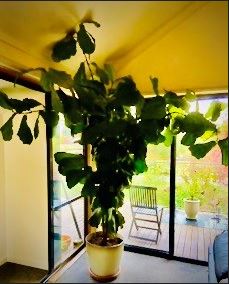May 29th, 2023Glen, about the house…

That’s not a ficus…this is a ficus!
Hi Glen,
I’ve just been reading your article in The Local regarding indoor plants in winter. Our ficus has been
slowly taking over the corner of our lounge room. I’m loath to trim it but seek your advice on the best
way of keeping it under control.
Kind regards, Wendy
Hi Wendy,
Thanks for the question. The fiddle-leaf ficus really should be called the finicky ficus – quite often difficult to get started but if placed into the right environment once they get going they’re almost bullet proof.
I’m glad you had the foresight to attach that (rather boastful) photo, because it enables me to give you a more detailed answer, which is yes, you can keep it under control and remove those mammoth arching branches.
As we are now entering the wintry season, and almost all growth slows to a stop, within reason you can really get going on the tidy-up. But it should be done in stages and with sharp secateurs, cutting just above a healthy stem, leaf or bud.
For starters take off the three or four long branches back to top of the cluster of leaves. That should be enough for the plant to take.
After a few weeks you might like to shorten the rest of them, perhaps even completely removing any spindly stems to encourage the rest. And generally tidy it up. I don’t need to tell you anything else, you are obviously already doing everything right.

Evergreen bulbous plants
Generally when gardeners think of bulbs, it’s probably daffodils or tulips and all the
others with an annual resting period.
However there are a great number of bulbous plants with the advantage that,
being evergreen, their foliage is a permanent feature in the garden. No long months
of bare spaces.
The most common and most widely known of these, of course, is the ubiquitous
agapanthus in all of its forms and colours, from the stately A. Praecox, with its tall,
slender-stemmed crown of white or blue flowers, down to the dainty variegated-leaved miniatures. Widely known as African lily, agapanthus proudly grace many
an Australian country front fence, including our own, and thrive with little or no
attention.
An interesting and worthwhile evergreen is arthropodium cirratum, the New
Zealand Rock Lily. This bulb produces arching sprays of attractive little flowers above
slender, evergreen foliage. It will grow quite happily in full sun in cool climates, but
needs semi-shade in warmer areas.
An excellent evergreen which can be grown as a pot specimen is clivia miniata,
(left photo above), which produces 50-60cm stems, topped by large balls of vibrant orange,
trumpet-shaped blooms. Clivia comes in many forms and colours, all hardy and
thriving in shady conditions.
Extremely hardy and exceptionally free flowering is tulbaghia violacea (centre
photo). Its narrow foliage is quite neat and it quickly forms a reasonable-sized clump.
Small heads of lilac flowers are borne on 30cm over a period of many months. They
will tolerate a wide range of soil conditions and grow well in full sun or partial shade.
Dietes is a group producing luxuriant strap-like foliage. D. Bicolor (right photo)
have 5cm lemon-yellow, iris-like flowers with three distinct brown and orange spots
in the centre of each flower. Growing to a metre in height they are adaptable to easily
grow in sun or shade.
Got a gardening query? Email glenzgarden@gmail.com









